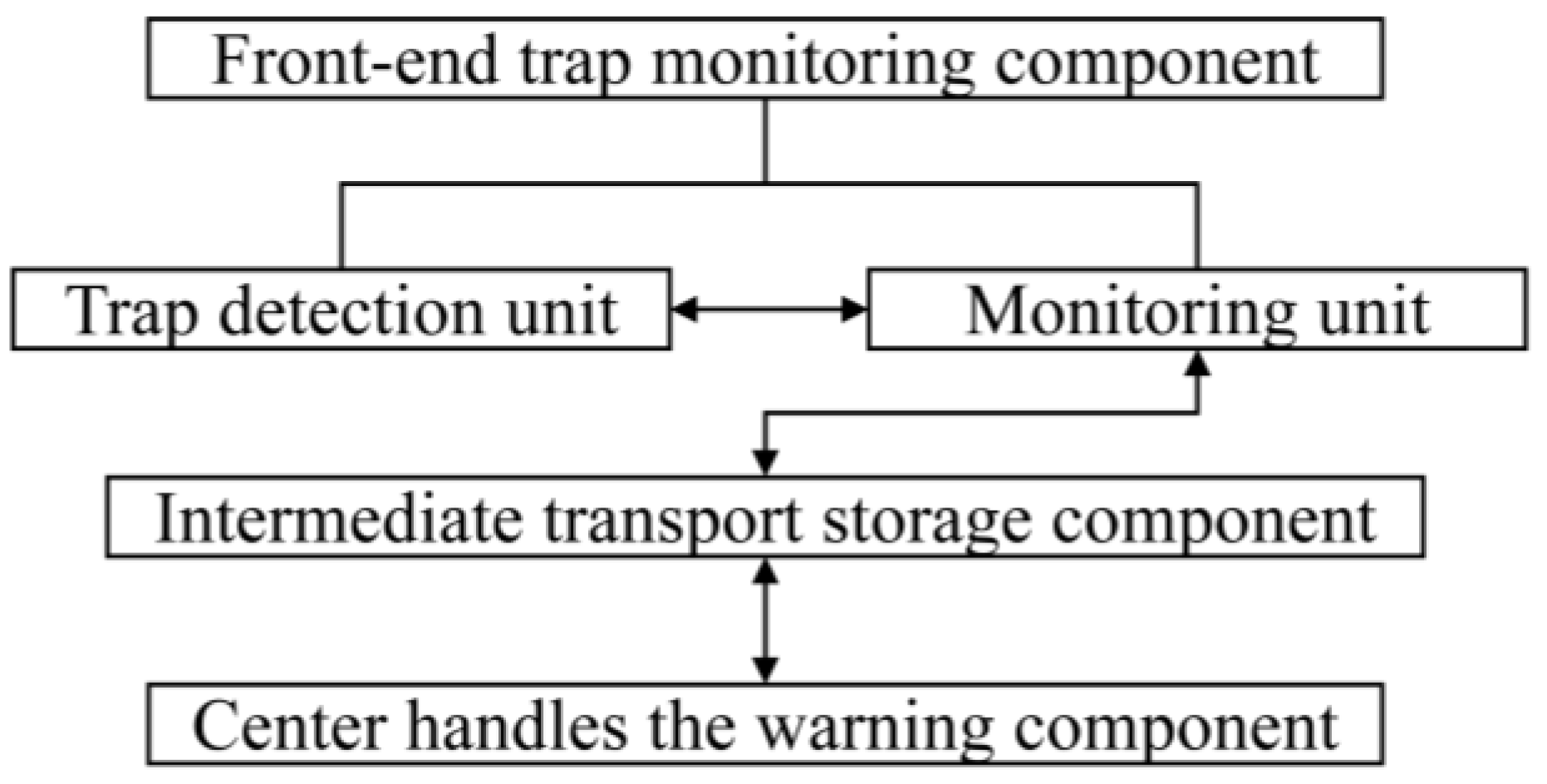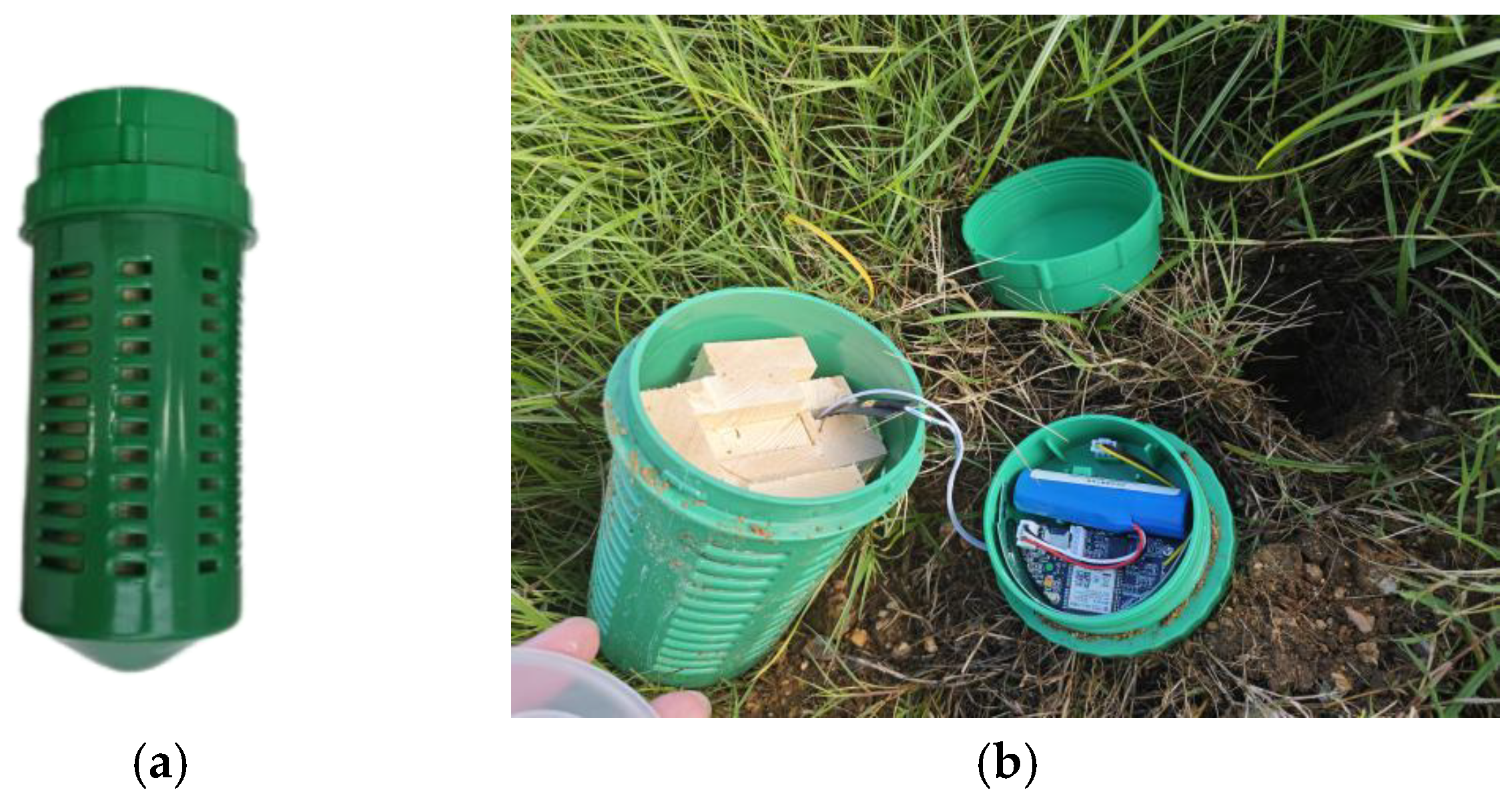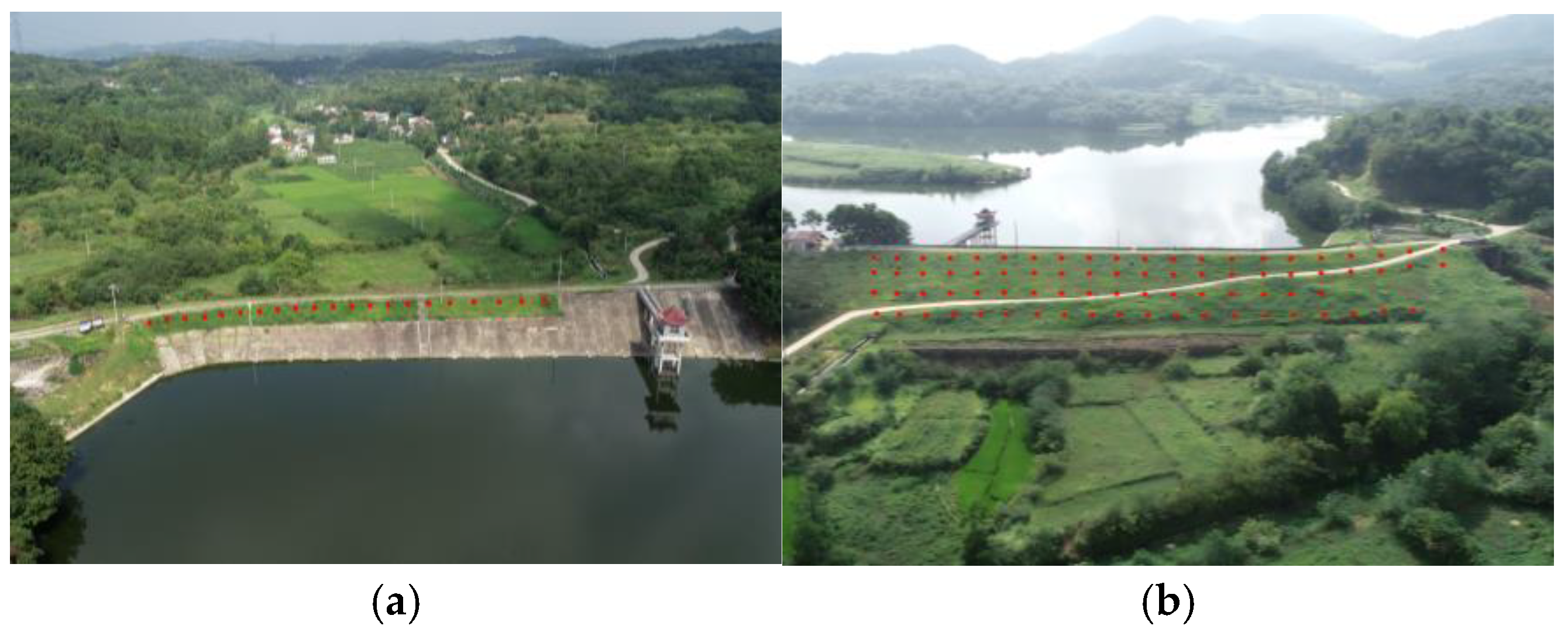Real-Time and Sustainable Termite Management: Application of Intelligent Monitoring Systems in Reservoirs
Abstract
1. Introduction
2. Intelligent Termite Monitoring Technology
- (1)
- Front-end trap monitoring component: This component is typically deployed in termite-prone areas and includes a trap detection unit and a monitoring unit. The trap detection unit primarily uses bait to attract termites and monitors the disturbance signals generated by termite clusters. The monitoring unit transmits and processes these signals.
- (2)
- Intermediate transmission and storage component: This section connects the front-end monitoring component with the central processing system. It is responsible for transmitting disturbance signals detected in the field, as well as storing and backing up relevant signal data.
- (3)
- Central processing and warning component: This section serves as the terminal system for the entire monitoring architecture. It receives and converts disturbance signals, issues timely warnings about termite cluster activity, and facilitates the implementation of preemptive control measures.
3. Material and Methods
3.1. Test Sites
3.2. The Bait-Based Termite Intelligent Detection System
- (1)
- Bait monitoring tube: The bait monitoring tube consists of an outer layer, an inner layer, and a top cap. The outer layer uses traps to lure termites, while the inner layer and top cap contain baits to trap termites. The bait used consists of a 4% Gramoxone powder mixed with 0.03% Gramoxone poison bait, prepared in a ratio of 1:1.5–3.3, with ivermectin as the active ingredient.
- (2)
- Baiting detection device: The baiting detection device consists of a detection rod and a detector. The detection rod attracts termites and generates anomalous electrical signals through a conductive powder material layer, while the detector transmits these signals to the monitoring unit.
3.3. Termite Intelligent Detection System Layout Method
3.4. Results
- (1)
- Strong real-time capability: Real-time monitoring is enabled through data collected by sensors, allowing for the timely detection of termite activity. This facilitates accurate monitoring, high efficiency, and environmental protection, while significantly enhancing the safety monitoring capabilities of water conservancy projects.
- (2)
- High degree of automation: The entire monitoring process operates without human intervention, reducing labor costs and time consumption, and improving the operational and management efficiency of water conservancy projects.
- (3)
- Scalability: The number and placement of sensors can be adjusted according to specific needs, allowing for flexible adaptation to different monitoring scenarios and ensuring comprehensive, full-coverage monitoring.
- (4)
- Advanced data analysis capability: By analyzing and mining large volumes of data, potential patterns and trends in termite activity can be identified, providing a solid scientific foundation for prevention and control measures.
4. Discussions
- (1)
- Construction of a data sharing platform: By establishing a unified data sharing platform, termite monitoring data from different regions can be integrated to create a comprehensive termite distribution map. This will support scientific research and inform policy development.
- (2)
- Application of artificial intelligence technology: By integrating artificial intelligence (AI) technology, more accurate termite identification and classification can be achieved, thereby enhancing monitoring efficiency and accuracy.
- (3)
- Mobile application development: With the widespread use of smartphones and tablets, specialized mobile applications can be developed to enable users to monitor and manage termite activity anytime and anywhere.
- (4)
- Development of a multi-level protection system: In addition to building-specific prevention and control measures, a multi-level protection system can be established by focusing on ecological balance, environmental management, and other aspects.
- (5)
- Integration with “digital twin” technology: By incorporating “digital twin” technology, a termite control operation and management platform can be built. This platform would rely on a base map, expand its capabilities, accumulate data, and carry out control operations in a more standardized manner.
Author Contributions
Funding
Institutional Review Board Statement
Informed Consent Statement
Data Availability Statement
Acknowledgments
Conflicts of Interest
References
- Boadi, S. Using Termite Mound Geochemistry and the Spatial Distribution of the Mounds to Support Subsurface Imaging. Master’s Thesis, University of Twente, Enschede, The Netherlands, 2018. [Google Scholar]
- Peveling, R. Long-term decline in harvester termites in Madagascar following multiple barrier treatments with fipronil against Migratory Locust. Agronomy 2022, 12, 310. [Google Scholar] [CrossRef]
- Ma, Y.; Zhao, R.; Shang, H.; Zhen, S.; Li, L.; Guo, X.; Yu, M.; Xu, Y.; Feng, J.; Wu, X. pH-responsive ZIF-8-based metal–organic-framework nanoparticles for termite control. ACS Appl. Nano Mater. 2022, 5, 11864–11875. [Google Scholar] [CrossRef]
- Hu, J.; Zhong, J.H.; Guo, M.F. Alate dispersal distances of the black-winged subterranean termite Odontotermes formosanus (Isoptera: Termitidae) in southern China. Sociobiology 2007, 50, 513–520. [Google Scholar]
- Ahmad, F.; Fouad, H.; Liang, S.; Hu, Y.; Mo, J. Termites and Chinese agricultural system: Applications and advances in integrated termite management and chemical control. Insect Sci. 2021, 28, 2–20. [Google Scholar] [CrossRef] [PubMed]
- Su, N.Y.; Scheffrahn, R.H. Foraging population and territory of the Formosan subterranean termite (Isoptera: Rhinotermitidae) in an urban environment. Sociobiology 1988, 14, 353–360. [Google Scholar]
- Togaev, U.; Turaev, A.S.; Mathur, V.; Tilyabaev, Z.; Zhaloliddinov, F.; Turageldiyev, S.; Shakirzyanova, G.; Khashimova, M.; Rustamov, K.; Matchanov, A. Innovative Strategies for Termite Management: Development and Evaluation of Effective Baits against Anacanthotermes turkestanicus. Biosci. Biotechnol. Res. Asia 2024, 21, 1429–1437. [Google Scholar] [CrossRef]
- Li, J.; Li, G.L.; Ju, H.L.; Zhang, T.T. Application of “Three Links and Eight Procedures” in Termite Control in Meizhou Dike. Guangdong Water Resour. Hydropower 2019, 12, 78–81. [Google Scholar]
- Tolossa, M. Termite, a hidden enemy of crops: A review. Am. J. Biosci. 2022, 10, 172–179. [Google Scholar]
- Oi, F. A review of the evolution of termite control: A continuum of alternatives to termiticides in the United States with emphasis on efficacy testing requirements for product registration. Insects 2022, 13, 50. [Google Scholar] [CrossRef]
- Fang, Z.; Li, H.; Ma, Y.; Zhang, M.; Gao, S.; Chen, B.; Shen, J.; Zhang, D. A wireless system for monitoring termite activity using electromagnetic induction with non-looping method. Appl. Sci. 2023, 13, 11956. [Google Scholar] [CrossRef]
- Wu, Y.M.; Zhang, J.J.; Li, H.T.; Yao, J. Application analysis of an intelligent termite monitoring system. Chin. J. Hyg. Insectic. Equip. 2020, 26, 76–78. [Google Scholar]
- Yang, N.; Xie, Y.C.; Zhang, M. Study on the promotion and application of remote real-time termite monitoring system in dams. Jiangxi Hydraul. Sci. Technol. 2023, 49, 57–59+78. [Google Scholar]
- Nanda, M.A.; Seminar, K.B.; Maddu, A.; Nandika, D. Identifying relevant features of termite signals applied in termite detection system. Ecol. Inform. 2021, 64, 101391. [Google Scholar] [CrossRef]
- Shen, J.F.; Yao, J. Development of a real-time automated monitoring and early warning system for termites in water conservancy and hydropower engineering based on “Demagnetic Induction Non-loop Break” (DEMINL) technology. In Proceedings of the 2018 Academic Annual Conference of the Chinese Hydraulic Engineering Society; China Water & Power Press: Nanchang, China, 2018; Volume 5, pp. 117–123. [Google Scholar]
- Kong, L.K. Intelligent Termite Monitoring Bait Station System Based on ZigBee. Electron. Technol. Softw. Eng. 2017, 1, 99. [Google Scholar]
- Yuan, G.; Wang, G.; Guo, X.; Zhang, J.; Zhai, Y. (Eds.) Application and prospect of geographic information system in comprehensive management of termites. In Insect Research of Central China; China Agricultural Science and Technology Press: Beijing, China, 2014; Volume 10, pp. 137–141. [Google Scholar]
- Qu, Z.B.; Cai, Q.X.; Zhang, S.T.; Shi, L.; Zhang, J.S.; Ding, K. Comprehensive termite prevention and control technology for rockfill dams in Xiaolangdi Multipurpose Dam Project on Yellow River. J. Ground Improv. 2021, 4, 13. [Google Scholar]
- Oliver-Villanueva, J.V.; Abián-Pérez, M.A. Advanced wireless sensors for termite detection in wood constructions. Wood Sci. Technol. 2013, 47, 269–280. [Google Scholar] [CrossRef]
- Achirul Nanda, M.; Boro Seminar, K.; Nandika, D.; Maddu, A. A comparison study of kernel functions in the support vector machine and its application for termite detection. Information 2018, 9, 5. [Google Scholar] [CrossRef]
- Nanda, M.A.; Seminar, K.B.; Nandika, D.; Maddu, A. Discriminant analysis as a tool for detecting the acoustic signals of termites Coptotermes curvignathus (Isoptera: Rhinotermitidae). Int. J. Technol. 2018, 9, 840–851. [Google Scholar] [CrossRef]
- Reynolds, D.R.; Riley, J.R. Remote-sensing, telemetric and computer-based technologies for investigating insect movement: A survey of existing and potential techniques. Comput. Electron. Agric. 2002, 35, 271–307. [Google Scholar] [CrossRef]
- Nanda, M.A.; Seminar, K.B.; Maddu, A.; Nandika, D. Acoustic and temperature signals generated by subterranean termite infestation: Its characteristics and implementations. All Life 2023, 16, 2167866. [Google Scholar] [CrossRef]
- Rust, M.K.; Su, N.Y. Managing social insects of urban importance. Annu. Rev. Entomol. 2012, 57, 355–375. [Google Scholar] [CrossRef]
- Pambudi, R.; Muslim, M.A. Flying Trap (Fly-T): An Automatic Termite Trapping Based on IoT and Hybrid Energy System using NodeMCU. J. Electron. Technol. Explor. 2023, 1, 71–76. [Google Scholar] [CrossRef]
- Ledmaoui, Y.; El Maghraoui, A.; El Aroussi, M.; Saadane, R. Review of Recent Advances in Predictive Maintenance and Cybersecurity for Solar Plants. Sensors 2025, 25, 206. [Google Scholar] [CrossRef] [PubMed]
- Lenz, M.; Evans, T.A. Termite bait technology: Perspectives from Australia. In Proceedings of the 4th International Conference on Urban Pests; Pocahontas Press: Charleston, SC, USA, 2002; pp. 7–10. [Google Scholar]
- Huang, Q.Y.; Li, G.H.; Liu, L.; Gao, Y.Y.; Xu, H.; Sun, P.D.; Jia, B.; Zhang, F.; Chen, L.J.; Li, M.W.; et al. Advances in rules of living habits and technologies of biological control on termites in dams and embankments. China Water Resour. 2023, 15, 54–59. [Google Scholar]
- Dhang, P. A preliminary study on elimination of colonies of the mound building termite Macrotermes gilvus (Hagen) using a chlorfluazuron termite bait in the Philippines. Insects 2011, 2, 486–490. [Google Scholar] [CrossRef]
- Davies, A.B.; Parr, C.L.; Eggleton, P. A global review of termite sampling methods. Insectes Sociaux 2021, 68, 3–14. [Google Scholar] [CrossRef]
- Kakkar, G.; Su, N.Y. Molting drives mortality in foraging populations of Formosan subterranean termites (Isoptera: Rhinotermitidae) baited with a chitin synthesis inhibitor, noviflumuron. Pest Manag. Sci. 2018, 74, 219–224. [Google Scholar] [CrossRef]
- Webb, G. Elimination of Coptotermes lacteus (Froggatt)(Blattodea: Rhinotemitidae) colonies using bistrifluron bait applied through in-ground bait stations surrounding mounds. Insects 2017, 8, 98. [Google Scholar] [CrossRef]





| Site | Months | TN | TP | FN | FP | AR% |
|---|---|---|---|---|---|---|
| The Suokoutan Reservoir 100 stations | 3 | 100 | 0 | 0 | 0 | 100% |
| 6 | 88 | 12 | 0 | 0 | 100% | |
| 9 | 40 | 54 | 0 | 6 | 94% | |
| 12 | 31 | 63 | 0 | 6 | 94% |
Disclaimer/Publisher’s Note: The statements, opinions and data contained in all publications are solely those of the individual author(s) and contributor(s) and not of MDPI and/or the editor(s). MDPI and/or the editor(s) disclaim responsibility for any injury to people or property resulting from any ideas, methods, instructions or products referred to in the content. |
© 2025 by the authors. Licensee MDPI, Basel, Switzerland. This article is an open access article distributed under the terms and conditions of the Creative Commons Attribution (CC BY) license (https://creativecommons.org/licenses/by/4.0/).
Share and Cite
Wang, M.; Jiang, P.; Wu, F.; Jiang, L.; Che, T. Real-Time and Sustainable Termite Management: Application of Intelligent Monitoring Systems in Reservoirs. Appl. Sci. 2025, 15, 3303. https://doi.org/10.3390/app15063303
Wang M, Jiang P, Wu F, Jiang L, Che T. Real-Time and Sustainable Termite Management: Application of Intelligent Monitoring Systems in Reservoirs. Applied Sciences. 2025; 15(6):3303. https://doi.org/10.3390/app15063303
Chicago/Turabian StyleWang, Ming, Peidong Jiang, Fengyan Wu, Lai Jiang, and Tengteng Che. 2025. "Real-Time and Sustainable Termite Management: Application of Intelligent Monitoring Systems in Reservoirs" Applied Sciences 15, no. 6: 3303. https://doi.org/10.3390/app15063303
APA StyleWang, M., Jiang, P., Wu, F., Jiang, L., & Che, T. (2025). Real-Time and Sustainable Termite Management: Application of Intelligent Monitoring Systems in Reservoirs. Applied Sciences, 15(6), 3303. https://doi.org/10.3390/app15063303






